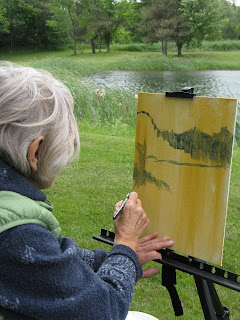I should have added a few other things about the big brush. My mentor was taught by Harold Boyes of Montreal. One of Harold's mantras was the use of a big brush. As big as you can stand then add a size. I didn't understand what he was trying to say for the longest time. He pointed out that there is six sides to a brush. So you have a myriad of painting surfaces. Oh, and by the way, a well maintained good brush has a razor sharp edge to it. You can do fine work with it if you train to do it.
To begin with, a big brush keeps you from starting at the finishing end. When I teach, this is one of the problems students have. No patience. Get to the end. Start with details. What's the secret? This in turn helps you stay focused on the concept.
To begin with, a big brush keeps you from starting at the finishing end. When I teach, this is one of the problems students have. No patience. Get to the end. Start with details. What's the secret? This in turn helps you stay focused on the concept.
Books and Lawyers Start
If you practice you will find that you can do just about everything with the big brush. More important, you will develop a fine appreciation for brush pressure, for the feel of the paint, for laying wet paint on top of wet paint. for glazing wet over wet. Yes, glazing wet over wet. This all supports doing work in one sitting. Alla Prima. And yet taking your time. Wasting few brush strokes.
Books and Lawyers - wet wash, wet shapes indicated
Using the large brush details are laid in either as small pieces of paint, as strokes over parts of underpaint revealing small pieces of paint, or just inferred - brush touches that make the viewer believe detail is there. After all, a viewer does not need to see detail, her eye will fill it in as required. That makes the painting forever interesting.




































